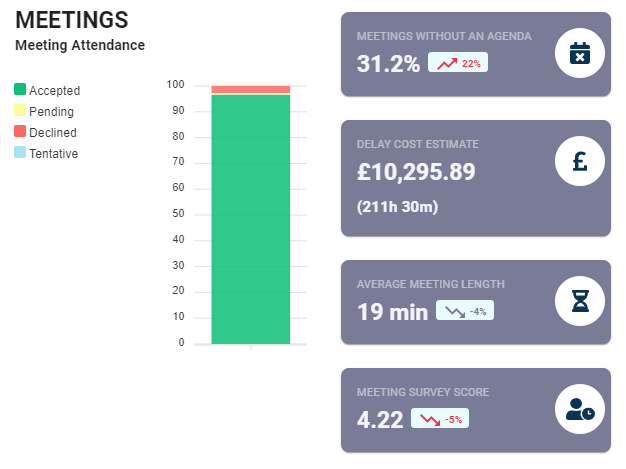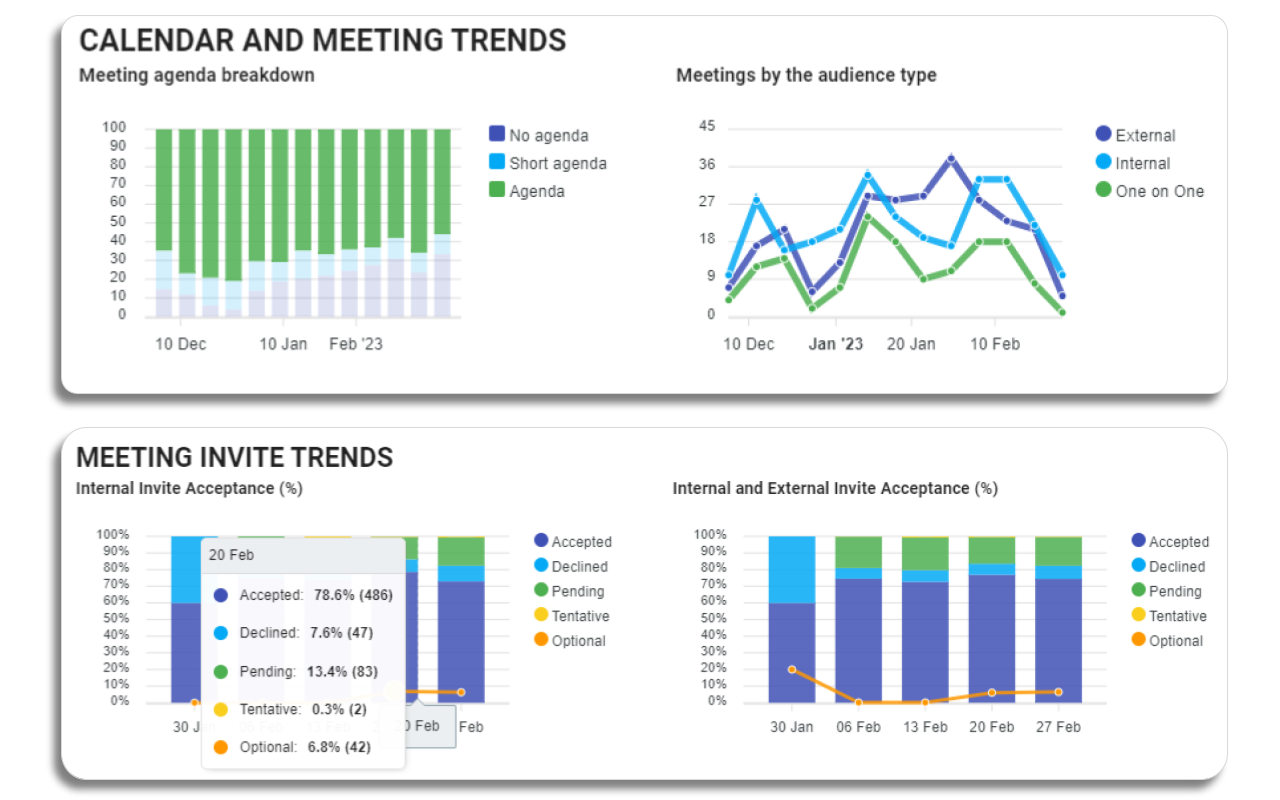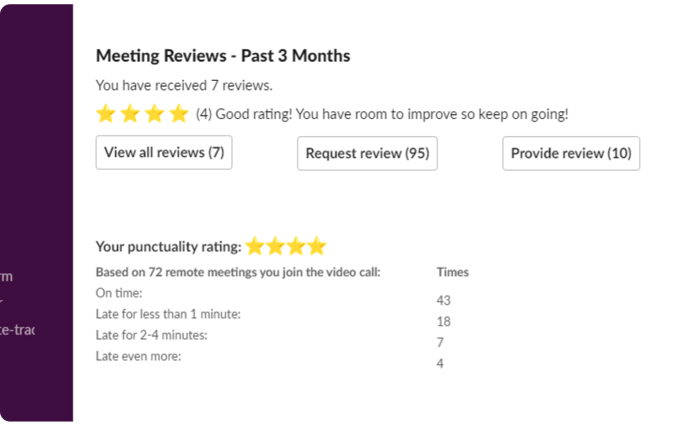The efficiency of meetings is essential when it comes to productivity and team output. For leaders, mastering the complexities of optimizing meeting time is crucial in guiding teams toward peak performance. Meetings that overrun or occur too often can impact productivity, and motivation, and cost the organization money. In this post, we will take a look at practical strategies and innovative analytics software that can reshift your meetings from time-consuming obligations into powerful activities of efficiency and productivity.
Understanding the Current Meeting Landscape
Meetings have evolved extensively in recent years, yet many managers are still dealing with the challenges of meeting inefficiency, or perhaps not even realizing it. Managers often find themselves grappling with meetings that lack clear objectives, resulting in discussions that meander without reaching conclusive outcomes. This inefficiency can manifest as meetings that run over time, unclear agendas, or the inclusion of attendees who have little to contribute to the discussion at hand.
The repercussions of these poorly managed meetings can lead to decreased productivity as the valuable time that could be spent on task execution or strategic planning is consumed by unproductive discussions. A Harvard Business Review survey highlights this impact, revealing that 71% of senior managers found meetings unproductive and inefficient. This sentiment underscores a widespread recognition of the need for optimized meeting management.
Also, meeting inefficiency isn't just about lost time, it's about the qualitative impact on team morale and engagement. Constantly being pulled into unnecessary meetings can lead to frustration and a feeling of stagnation among team members. This, in turn, can affect the overall work environment, leading to decreased motivation and a potential decline in work quality.
The direct and indirect costs of these inefficiencies are substantial. A study by Doodle's 2019 State of Meetings report estimated that poorly organized meetings could be costing companies $399 billion in the U.S. alone. This staggering figure reflects not only the time wasted but also the lost opportunities for growth and innovation that occur when teams are not working optimally.
In this context, it's evident that understanding and addressing meeting inefficiency is not just a matter of scheduling or administrative logistics. It's a strategic imperative for leaders who aim to foster a productive, engaged, and innovative workforce.
Strategies for Efficient Scheduling

Efficient scheduling is the start of promoting productive meetings. It begins with setting clear objectives for each meeting, ensuring that every participant understands the purpose and expected outcomes. Without a defined goal, meetings can quickly become aimless, wasting valuable time. Managers should articulate what needs to be achieved, whether it's making a decision, brainstorming ideas, or disseminating information
Agendas are the roadmap for meetings. A well-crafted agenda outlines the topics to be discussed and allocates time for each item. This keeps the meeting structured and focused, preventing side conversations that can derail the discussion. It's also courteous to share the agenda in advance, giving participants time to prepare, which leads to more engaged and productive discussions.
Time limits are crucial in maintaining meeting discipline. Prolonged meetings can lead to fatigue and diminished attention, counteracting productivity. Setting a strict time frame encourages participants to be concise and stay on topic. It also fosters a sense of urgency, prompting quicker decision-making and more efficient problem-solving.
Selective participant inclusion is another key strategy. Inviting only those who are directly involved or have a significant contribution ensures that discussions are relevant and decisions are expedited. Overcrowding meetings with unnecessary attendees can lead to diluted conversations and a lack of accountability. Managers need to critically assess who needs to be in the meeting and why.
Efficient scheduling is about enhancing the quality and output of meetings. By setting clear objectives, crafting detailed agendas, enforcing time limits, and being selective with invitations, managers can significantly improve meeting efficiency. This approach not only saves time but also boosts productivity and ensures that meetings are a valuable asset rather than a time sink.

Maximizing Meeting Productivity

Maximizing meeting productivity is vital in ensuring that the time invested in meetings translates into tangible outcomes and progress. Engaging participants is the first step toward this goal. Managers should foster an inclusive atmosphere where everyone feels encouraged to contribute. Techniques like asking open-ended questions, inviting input from quieter members, and using collaborative tools can make all the difference. This ensures diverse perspectives are heard, enriching the discussion and leading to well-rounded decisions.
Ensuring actionable outcomes is equally critical. Every meeting should conclude with a clear set of actions, assigned responsibilities, and deadlines. This clarity prevents ambiguity and drives momentum post-meeting. Participants should leave the room with a precise understanding of what is expected of them and by when. This not only keeps projects moving forward but also instills a sense of accountability and purpose.
The role of follow-ups and accountability cannot be overstated in maximizing meeting time. Regular check-ins and updates on progress keep tasks on track and team members accountable. They reinforce the importance of commitments made during meetings and ensure that discussions translate into action. Managers can use various tools and strategies for effective follow-ups, including setting reminders, using project management software, or scheduling brief check-in meetings.
Additionally, it's important to foster a feedback culture where participants can reflect on the meeting's effectiveness and suggest improvements. This continuous loop of feedback and improvement can lead to more focused, efficient, and productive meetings over time.
By engaging participants effectively, ensuring actionable outcomes, and emphasizing follow-ups and accountability, managers can significantly enhance the productivity of meetings. These strategies ensure that meetings are not just a routine part of the workday but a valuable tool for progress and team cohesion. Maximizing meeting productivity is an ongoing process, but with the right approach, it can lead to a more focused, effective, and motivated team.
Optimize Meeting Time With Flowtrace

Flowtrace's analytics provide a detailed understanding of how meetings are conducted within an organization. It can identify inefficiencies such as recurrent unproductive meetings, excessive meeting durations, or frequent meetings with little to no significant outcomes. By analyzing patterns over time, Flowtrace helps managers pinpoint areas where changes are needed, whether it's adjusting the frequency of meetings, shortening their duration, or altering the participant list to include only those directly involved in the agenda.
The feedback mechanisms are integral to continuous improvement. After each meeting, participants can provide feedback, offering insights into what worked and what didn't. This continuous loop of feedback ensures that each meeting is an opportunity for refinement. Over time, this can lead to a more engaged meeting culture, where all participants feel their time is valued and their contributions matter.
Flowtrace's meeting cost calculators and other metrics provide a clear, quantifiable view of the direct and indirect costs associated with meetings. Understanding these costs can be a revelation for many organizations, demonstrating the financial impact of inefficient meetings and the potential savings of optimization. Managers can use these metrics to justify changes in meeting policies and practices, demonstrating the financial as well as the productivity benefits of well-optimized meetings.
Flowtrace offers a comprehensive overview of meeting analytics that provide a robust framework for optimizing meeting time. From identifying inefficiencies through analytics to encouraging ongoing improvement through feedback to understanding the financial impact through cost calculators, Flowtrace empowers managers to transform their meetings. The result is a more efficient, productive, and engaged team, where meetings are a tool for progress, not a hindrance.
Conclusion
Optimizing meeting time is crucial for team leaders aiming to enhance productivity and drive results. By adopting strategies and utilizing analytics offered by Flowtrace, managers can transform their meetings into efficient, outcome-driven sessions. Embracing these tools and techniques not only streamlines meetings but also fosters a culture of effectiveness and accountability.
